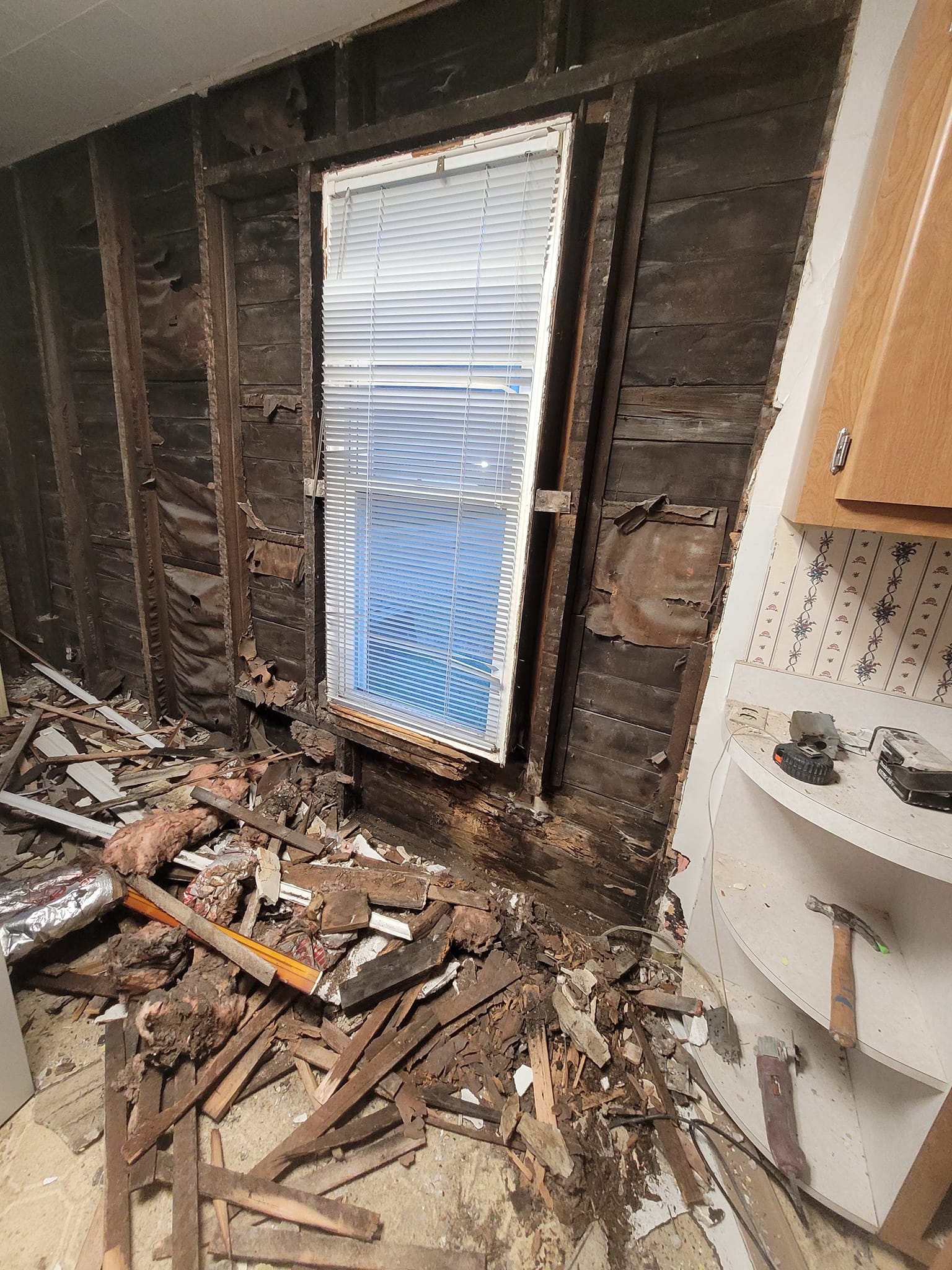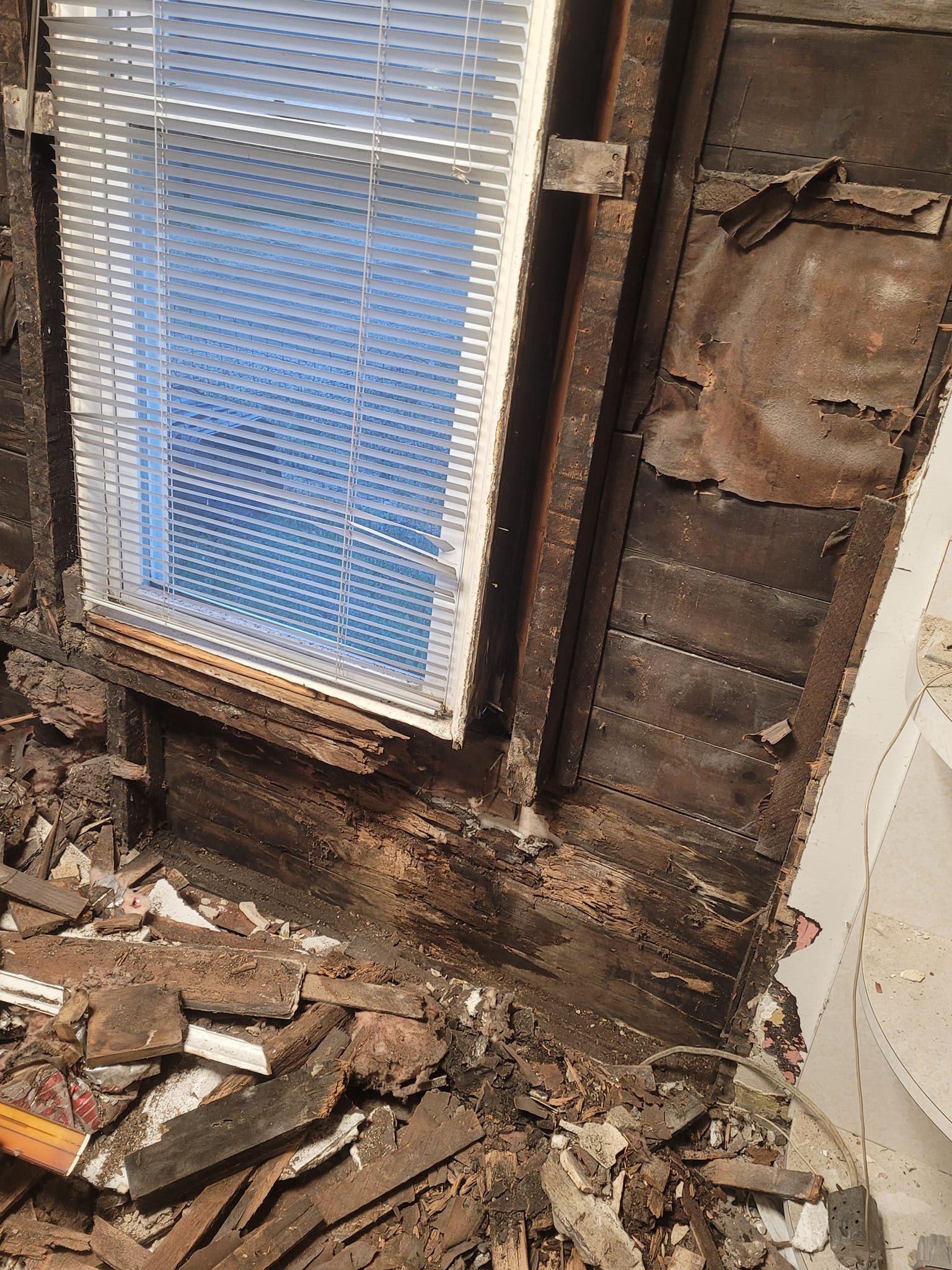How should I proceed with reframing a window and replacing siding after discovering issues while taking down old plaster?
10 months ago
Last Updated: August 14, 2024
I found something while removing old plaster and now I’m thinking I need to reframe the window. But what about the wood for the siding? Do I have to take the siding down too? Thanks for any help, I’m figuring things out as I go along.


I would personally recommend using a bleach water solution, with 25% bleach, if you notice mold or mildew. Clean the affected area, let it dry, and then cover it up again, unless it’s severely damaged. Be cautious not to start tearing down your exterior wall as it may lead to more work than you anticipate.
Understands the feeling of being in over your head with challenging tasks – it’s an opportunity to discover your true capabilities!
Recommends using ammonia or vinegar instead of bleach to remove mold.
CLR is actually even better, just spray and wipe.
Yea vinegar, that’s what my wife uses. I suppose bleach would be more suitable for outdoor use.
Money is often the main issue for . I can handle a lot of things, just can’t afford it when it comes to my own home lol. I do what I need to do. If I can wait, I do.
By the way, bleach might make mold turn white and could help prevent it, but it’s not the best at getting rid of the problem. Trust me, we’ve had our fair share of remediation experiences! 😉
Plus, bleach doesn’t fully eliminate mold since it doesn’t reach the roots.
Hey, just a heads up! I avoid using bleach to spray mold because it can actually make the situation worse. I always opt for a fungicide instead, and all the contractors I work with are certified in mold removal, so no bleach for us!
Just a heads up that bleach is effective in killing mold on solid/non-porous surfaces, while vinegar or fungicide works best on porous surfaces. Looks like there’s quite a bit of visible rot going on.
Oh no, , it looks like the wood has completely rotted away! 😂 Remember, bleach should not be used on mold and mildew as it can do more harm than good. Try using enzyme fungicides instead on mold and mildew affecting organic materials.
Hey, have you tried using cleaning vinegar, ?
Did you know that spraying mold can spread the spores? There are safer ways to handle it, like using an adhesive film for containment. Better to be cautious with repairs!
Just a heads up, bleach doesn’t fully get rid of mold in wood. It can be tricky, best to use a mold killer for a thorough job.
Clean then apply veneer
I understand we are trying to save money, but those walls are in bad shape. The water damage is pretty bad and there are clear signs of mold. Brace yourself for a wave of criticism.
I’m really not trying to be rude, but it seems like that turned into a pretty big project! It looks like the entire wall might need to be rebuilt…
Not the entire wall but for sure that specific area. Perhaps remove part of the sill plate and address the rot on that stud to reinforce it.
Unless you intend to replace it, I wouldn’t recommend removing the shiplap. In many older homes, shiplap actually serves a structural purpose. It may be the reason why the window is still intact.
The issue here is whether you have vinyl siding. You would need to remove it above the problem area and cut out the damaged section. You’d also have to reinforce the 2×4, adding a horizontal piece and two new supports for the replacement. You can swap out the wood siding (exterior wall) with plywood, just make sure it’s properly braced. Taking down the entire wall isn’t necessary.
When working on siding, it’s important to remove entire rows properly to avoid damaging the section you need to cut out.
That seems like it could be dry rot. If it is, it’s important to remove it because it has the potential to spread.
My suggestion would be to bring it down. As high as you can. Why do a half-hearted job leaving all the decayed wood underneath to potentially cause issues later on? I know money might be tight, but in the long term, it could end up saving you money. I’m not sure where you’re located or what the building code is, but using 2x4s and 2x6s for framing, along with some sheathing on the walls, will provide a much stronger foundation for attaching your siding. If you’re feeling out of your element with this much work, consider asking around for advice – even places like Home Depot typically have knowledgeable staff who can offer suggestions on how to proceed.
I had a similar issue with my house. I ended up having to replace the whole wall in the back bedroom. I think it’s worth investing the money, if you can, to remove and replace it now instead of waiting for it to get worse. Once you fix the leak in the window sill, it should be good.
Edit: It doesn’t appear the whole wall needs to be taken out, but definitely the bottom section and any rot on the stud, window framing, and maybe part of the sill plate. Most of the stud should be salvageable. Just reinforce what’s necessary and you should be fine.
That is something that can definitely be resolved. It’s time to start reframing.
Not too terrible, it appears that the damage spans 2-3 feet by 1-2 feet. Definitely need to reframe the window. While you’re at it, remove a few shiplaps at the bottom and replace the ones that are damaged. Proper flashing and caulking should take care of the issue.
Oh man. If you’re dealing with serious structural decay due to rot or termites, it might be a good idea to reach out to your home insurance provider. It could get risky if it poses a threat to health or the integrity of the structure. I’d recommend getting in touch with a public adjuster. The damage is definitely reparable, but it’s important to understand the full scope of the necessary repairs.
It’s clear where the window was leaking from, isn’t it?
Remove any wood that is moldy, rotten, or mildewed. Be sure to inspect for insects, particularly carpenter ants and termites. If you discover any signs of infestation, treat the affected area. For damaged wood, cut back 12 inches to reach solid material. Treat any remaining affected areas with enzyme fungicides before beginning the rebuilding process. Best of luck!
Old balloon framing…
Windows are situated too near the deck based on current building codes, so let’s remove the rot and reframe to meet code standards
You’ll need to reattach the sheathing, but you can definitely do the structural work from inside. With that much rot, your sill will likely be in bad shape too, and that’s not a job for a homeowner to tackle. It’s best to have someone who knows what they’re doing assess it. This is why it’s important for homeowners to have their homes properly inspected – there could be more issues lurking. Modern windows are much better at keeping water out, and we make sure to double flash them for added protection. Hopefully it’s just that one stud, but it might be worth further exploration.
It’s actually pretty common. You’ll need to remove everything down to the studs and replace the sill, outside sheathing, and a few studs after the bracing is put in. It’s definitely a bigger project than you thought, but it happens quite often.
Make sure to replace the window after you replace the wood so that the window looks ready to go.
In my experience, the most effective way to deal with mold is using liquid hand sanitizer. You can find affordable options on Amazon that contain alcohol and disinfectant. I have tried numerous methods in the past, but this one has proven to be the most successful. You can purchase a battery-operated spray bottle for $10 at Lowe’s: https://a.co/d/9tvlSG2
Instead of bleach, consider using concrobium for mold.
Oh, the fun of working on an old house! My home was constructed in 1790, each task seems to multiply into three…
Right? It’s crazy how one small fix can turn into a huge project. Our house is the same way, always surprises popping up.
I own a house from 1865. When I once cut a hole for an outlet, I ended up removing 10′ of plaster and replacing the base plate that was no longer there. Additionally, I had to fix the bottom 8″ of each stud. The siding was the only thing keeping the wall up.
The wooden planks should be left as is. If necessary, only replace the outer siding. Add 3″ of closed cell foam to those walls after finishing your electrical and plumbing updates.